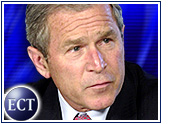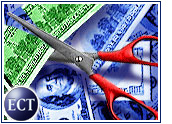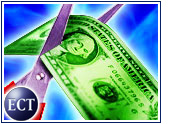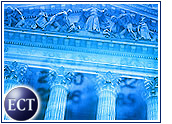
News on Tuesday that the U.S. Federal Reserve had announced its ninth interest rate cut of 2001 briefly jiggered tech stocks, but left no apparent change in the long-term forecast for the sector.
After dipping from positive into negative territory upon the official release of the news, tech stocks quickly recovered to finish the day in the black. The Nasdaq closed Tuesday at 1,492.33, up 11.87. By comparison, the Dow Jones Industrial Average finished very strongly, rising from the red in the last hour to close at 8,950.59, up 113.76.
The Federal Open Market committee said it had lowered its target for the federal funds rate by 50 basis points to 2.5 percent, and cutting the discount rate to 2 percent.
The September 11th terrorist attacks on the United States continue to reverberate on the economy, with the central bank of the United States issuing its rate cut only 15 days after its previous move — the shortest span between cuts this year.
Short-Term, Long-Term
“The terrorist attacks have significantly heightened uncertainty in an economy that was already weak,” the Fed said in explaining its latest action, which had been widely expected. “Business and household spending as a consequence are being further damped.”
“The Committee continues to believe that, against the background of its long-run goals of price stability and sustainable economic growth, and of the information currently available, the risks are weighted mainly toward conditions that may generate economic weakness in the foreseeable future.”
In what has become something of a waiting-for-Godot exercise among tech businesses and investors, the Fed reiterated that recovery will come … sometime.
“The long-term prospects for productivity growth and the economy remain favorable and should become evident once the unusual forces restraining demand abate,” the Fed said.
If You Cut It …
The Fed’s most recent rate cut came September 17th, minutes before financial markets opened for the first time following the terrorist attacks.
On New Year’s Day, the Fed’s target interest rate stood at 6.5 percent. Since then, rate cuts have come approximately every 30 days on average, reducing that figure 61.5 percent.
Not once in 2001 has the Fed gone more than two months without a rate cut. The lending rate is now reportedly at its lowest since 1962.
… Recovery Will Come?
When the rate cuts began this year, tech sector analysts said that the lower borrowing costs would begin to help tech companies in about six months, by encouraging corporate spending in hardware, software and services.
Summer arrived without much sign of revival, at which point analysts interviewed by the E-Commerce Times said that the tech downturn stemmed from more than just a weak economy.
According to some observers, the rate cuts essentially came too late to stem the shakeout in the overextended dot-com economy, and could do nothing to change the fact that most consumers and businesses already had the computer systems they needed to function for the time being.
Stocks Mixed
The bellwethers of the Nasdaq were the most active stocks on the exchange Tuesday. Cisco (Nasdaq: CSCO) closed at US$11.48, down 42 cents. Intel (Nasdaq: INTC) fell 47 cents to $19.54, while Sun (Nasdaq: SUNW) slid 12 cents to $8.01.
The E-Commerce Times stock index was higher, rising 3.35 points to 109.41. Amazon (Nasdaq: AMZN) inched up 7 cents per share to $6.08, while eBay (Nasdaq: EBAY) rose 52 cents to $47.49.














































(1) Agree that most companies do not feel compelled to purchase (or upgrade) computer
equipment. In addition, capital purchases and efficiency improvements over the
past few years have phenomenally increased manufacturing capabilities (and capacities).
Therefore, in general, why buy more capital if the demand is missing-in-action?
(2) The demand side that needs to be addressed relates to interest rates for “credit
card debt”! Credit card debt has increased at an alarming rate over the past decade
(from ~$250B to $750B). People were clearly spending beyond their incomes! However,
the rates charged for credit card debt are still MUCH too high. Lower those interest
rates … and see the increase in disposable income. Allow debtors a long-term solution,
rather than a hopeless outlook at current high interest rates. Some debtors may require
some disciplined financial management training (in exchange for lowered rates?). Help
break the debt cycle & spend more wisely (oh, sorry, that’s not what we want – right!?!).
(3) Finally, the 30 year fixed mortgage rates have not really changed much at all.
Thanks.